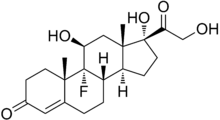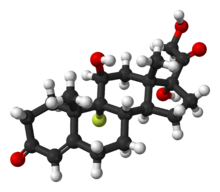Fludrocortisone
 |
|
 |
|
| Clinical data | |
|---|---|
| AHFS/Drugs.com | Monograph |
| Pregnancy category |
|
| Routes of administration |
by mouth |
| ATC code | |
| Legal status | |
| Legal status |
|
| Pharmacokinetic data | |
| Protein binding | High |
| Metabolism | liver |
| Biological half-life | 3.5 hours |
| Identifiers | |
|
|
| Synonyms | 9α-fluorocortisol, 9α-fluorohydrocortisone |
| CAS Number | |
| PubChem CID | |
| IUPHAR/BPS | |
| DrugBank | |
| ChemSpider | |
| UNII | |
| KEGG | |
| ChEBI | |
| ChEMBL | |
| ECHA InfoCard | 100.004.395 |
| Chemical and physical data | |
| Formula | C21H29FO5 |
| Molar mass | 380.45 g/mol |
| 3D model (Jmol) | |
|
|
|
|
|
|
|
Fludrocortisone, sold under the brand name Florinef among others, is a corticosteroid used to treat adrenogenital syndrome, postural hypotension, and adrenal insufficiency. In adrenal insufficiency it is generally taken together with hydrocortisone. It is taken by mouth.
Common side effects include high blood pressure, swelling, heart failure, and low blood potassium. Other serious side effects include low immune system function, cataracts, muscle weakness, and mood changes. It is unclear if use during pregnancy is safe for the baby. Fludrocortisone is mostly a mineralocorticoid; however, also has glucocorticoid effects.
Fludrocortisone was patented in 1953. It is on the World Health Organization's List of Essential Medicines, the most effective and safe medicines needed in a health system. In the United Kingdom it costs the NHS about 1.52 pounds per month. In the United States the wholesale cost of a month of medications is about 11.96 USD.
Fludrocortisone has been used in the treatment of cerebral salt wasting syndrome. It is used primarily to replace the missing hormone aldosterone in various forms of adrenal insufficiency such as Addison's disease and the classic salt wasting (21-hydroxylase deficiency) form of congenital adrenal hyperplasia. Due to its effects on increasing Na+ levels, and therefore blood volume, fludrocortisone is the first line of treatment for orthostatic intolerance and postural orthostatic tachycardia syndrome (POTS). It can be used to treat low blood pressure.
...
Wikipedia
